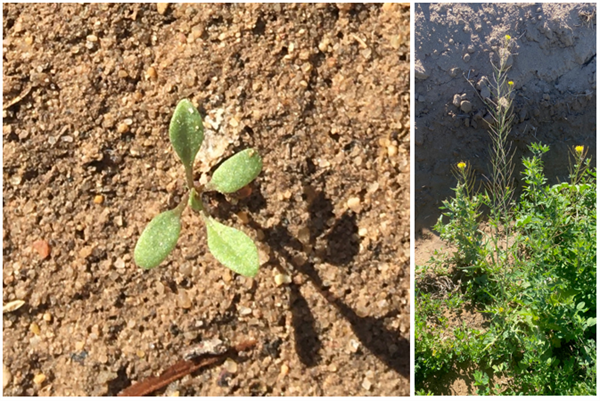London Rocket (Sisymbrium irio)
If you drive through the Valley of Yuma Arizona this week you will see a significant amount of London rocket, a winter annual broadleaf weed from the family of the Brassicaceae. We can see it in already harvested lettuce fields, edges of alfalfa fields, on roadsides, orchards, and gardens.
Why London Rocket? According to some sources the common name "London rocket" allegedly comes from its abundance after the Great Fire of London in 1666 even though years later Dr E J Salisbury failed to find specimens in a study in 1940 [1].
The seed leaves (cotyledons) are oval, around 2–6 mm long, without pubescence. True leaves are a bit larger than the cotyledon, has smooth edges or a few weak teeth, and is on a long stalk. Leaves are alternate on the stem.
The mature plant grows approximately 24-36” tall in our area. It grows erect and ranches are mostly close to the base of the plant. The leaves have very little pubescence and have opposite lobes. Right now, we can see its abundant yellow flowers in our area and grow in clusters at the top of the stems (pic below). The fruits are 1-1.5” seedpods that are straight or a little curved and about 1mm wide.
Here in the “Lettuce capital of the world” this weed can be a problem because of it is highly competitive.
In lettuce production the application of Kerb (Pronamide) has shown good London rocket control when applied properly. This means not too early or with too much sprinkler irrigation to avoid leaching. Delayed application is often needed, and the location of the herbicide is critical for best performance. Approximately 1-3 days after starting sprinklers for early plantings (Aug-Sep) and from 3-6 days for mid-season plantings (Oct-Nov) [3].
Interestingly, medical researchers tested some extracts of seeds and found it showed significant antipyretic and analgesic effects and antibacterial action [2]. Other medicinal properties have been reported such as the reduction of swelling and use for cleaning of wounds, rheumatism relief, chest congestion, cough, detoxify the liver and spleen [1].
When weeds like London Rocket are infesting our lettuce or alfalfa fields, they can be such a nuisance. But it's possible that in other parts of the world people are looking for them as beneficial herbs.

London rocket seedling and mature plant in alfalfa field.
References:
1. Retrieved from: https://en.wikipedia.org/wiki/Sisymbrium_irio
2. Antipyretic, Analgesic and Antimicrobial Studies on Sisymbrium irioS. B. Vohora, S. A. H. Naqvi, I. Kumar (1980) Institute of History of Medicine & Medical Research, Tughlaqabad, New Delhi (India).
3. Retrieved from: https://www.farmprogress.com/timing-critical-kerb-herbicide





